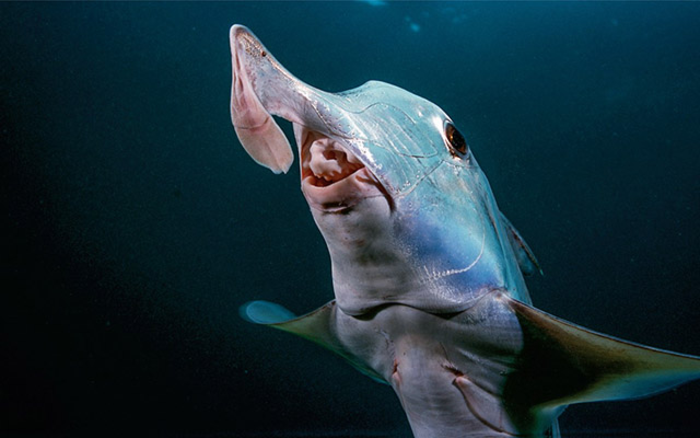Researchers at University of California San Diego School of Medicine and in Japan have used an ancient fish to reel in new insights about human biology and, in particular, how and why a widely used medication works to abort pregnancies (in people, not fish).

Credit: Michael Baker, UC San Diego Health Sciences
Researchers at University of California San Diego School of Medicine and in Japan have used an ancient fish to reel in new insights about human biology and, in particular, how and why a widely used medication works to abort pregnancies (in people, not fish).
The findings published in the February 11, 2022 online issue of ACS Pharmacology & Translational Science.
The elephant shark (Callorhinchus milii) is an unusual looking and uncommon animal model. Known by several names, such as ghost shark, elephant fish and silver trumpeter, the species is found in waters off southern Australia. The smooth-skinned, cartilaginous fish grows to a maximum size of four feet and poses no threat to humans. Their distinctive hoe-shaped, proboscis-like snout is used to detect prey, primarily shellfish and bottom-dwelling invertebrates, through movement and weak electrical fields.
But it’s a different attribute that makes elephant sharks suitable for certain kinds of research: They belong to the oldest group of jawed vertebrates and have the slowest evolving genome of all known vertebrates, which make them ideal for investigating how some biological systems have evolved in bony vertebrates, including humans. The latest study, comparing progesterone receptor (PR) activation in elephant sharks and humans, provides insights in how steroid activation evolved in the latter, and why it works the way it does today.
Progesterone is a hormone that, in women, regulates the menstrual cycle, preparation for conception and maintaining a pregnancy. The effects of progesterone are mediated by its nuclear receptor, PR. Researchers found that PR activation in elephant sharks requires a different mix of hormones and steroids than PR activation in humans, with the latter requiring fewer but more specific hormonal and steroidal triggers.
More interestingly, they discovered that RU486, a medically approved clinical compound that blocks or terminates pregnancy in humans and is commonly called “the abortion pill,” does not have the same effect in elephant sharks. It does not inhibit progesterone activation of elephant shark PR.
The findings, said senior author Michael Baker, PhD, research professor at UC San Diego School of Medicine, illuminate the divergent evolutionary paths of fish and humans, and offer insight about how other more popular animal models, specifically zebrafish, might be problematic when attempting to parse the pathology of endocrine disruption (when natural or manmade chemicals mimic or interfere with hormones that regulate development, reproduction and other basic functions) or develop new drugs.
Co-authors include: Xiaozhi Lin, Shigeho Ijiri and Yoshinao Katsu, Hokkaido University, Japan; and Wataru Takagi and Susumu Hyodo, University of Tokyo
# # #
Journal
ACS Pharmacology & Translational Science
DOI
10.1021/acsptsci.1c00191
Article Publication Date
11-Feb-2022




